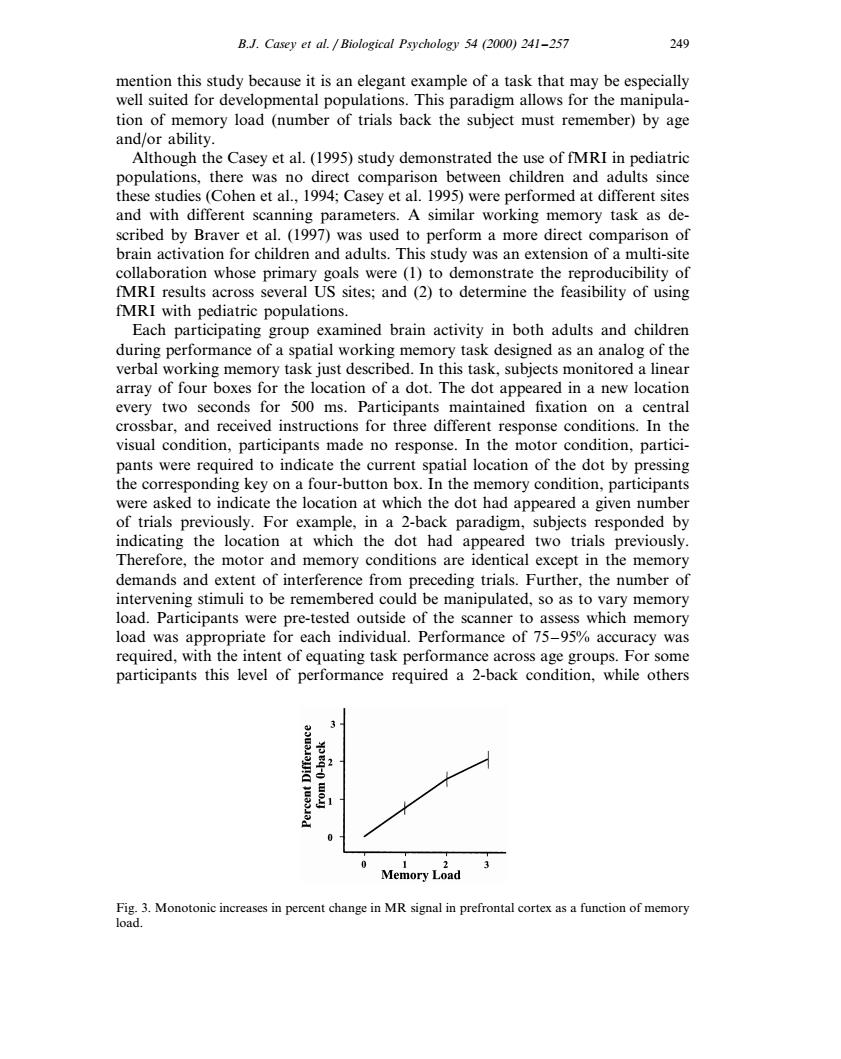正在加载图片...

B.J.Casey et al./Biological Psychology54(2000)241-257 249 tion of memory load (number of trials back the subject must remember)by age and/or ability. Although the Casey et al.(1995)study demonstrated the use of fMRI in pediatric populations,there was no direct comparison between children and adults since these studies (Cohen et al.,1994:Casey et al.1995)were performed at different sites and with differer t scanning arame ers.A similar rking memory task as de- scribed by r et al.(1997) was use to perform a more direct comparison of brain activation for children and adults.This study was an extension of a multi-site collaboration whose primary goals were(1)to demonstrate the reproducibility of fMRI results across several US sites;and(2)to determine the feasibility of using fMRI with pediatric populations. Each participating group examined brain activity in both adults and children during performance of spatial working memory task designed as an analog of the ng m ask just describ ed.In this task,subjects m array of f ry t four box a dot The every two seconds for 500 ms appea red in a new locatio Participants maintained fixation on a centra crossbar,and received instructions for three different response conditions.In the visual condition,participants made no response.In the motor condition,partici- pants were required to indicate the current spatial location of the dot by pressing the corresponding key on a four-button box.In the memory condition,participants were asked to indicate the location at which the dot had appeared a given number of trials e in a 2haok pa ubjects espo nded by ng the location at which the dot had appeare two trials eviously Therefore.the motor and memory conditions are identical except in the memory demands and extent of interference from preceding trials.Further,the number of intervening stimuli to be remembered could be manipulated,so as to vary memory load.Participants were pre-tested outside of the scanner to assess which memory load was appropriate for each individual.Performance of 75-95%accuracy was required,with the intent of equating task performance across age groups.For some participants this level of per required a 2-back condition.hile others 0 Memory Load otoniceass in percent change in MR sigan prefrontal cortex asfunctiB.J. Casey et al. / Biological Psychology 54 (2000) 241–257 249 mention this study because it is an elegant example of a task that may be especially well suited for developmental populations. This paradigm allows for the manipulation of memory load (number of trials back the subject must remember) by age and/or ability. Although the Casey et al. (1995) study demonstrated the use of fMRI in pediatric populations, there was no direct comparison between children and adults since these studies (Cohen et al., 1994; Casey et al. 1995) were performed at different sites and with different scanning parameters. A similar working memory task as described by Braver et al. (1997) was used to perform a more direct comparison of brain activation for children and adults. This study was an extension of a multi-site collaboration whose primary goals were (1) to demonstrate the reproducibility of fMRI results across several US sites; and (2) to determine the feasibility of using fMRI with pediatric populations. Each participating group examined brain activity in both adults and children during performance of a spatial working memory task designed as an analog of the verbal working memory task just described. In this task, subjects monitored a linear array of four boxes for the location of a dot. The dot appeared in a new location every two seconds for 500 ms. Participants maintained fixation on a central crossbar, and received instructions for three different response conditions. In the visual condition, participants made no response. In the motor condition, participants were required to indicate the current spatial location of the dot by pressing the corresponding key on a four-button box. In the memory condition, participants were asked to indicate the location at which the dot had appeared a given number of trials previously. For example, in a 2-back paradigm, subjects responded by indicating the location at which the dot had appeared two trials previously. Therefore, the motor and memory conditions are identical except in the memory demands and extent of interference from preceding trials. Further, the number of intervening stimuli to be remembered could be manipulated, so as to vary memory load. Participants were pre-tested outside of the scanner to assess which memory load was appropriate for each individual. Performance of 75–95% accuracy was required, with the intent of equating task performance across age groups. For some participants this level of performance required a 2-back condition, while others Fig. 3. Monotonic increases in percent change in MR signal in prefrontal cortex as a function of memory load